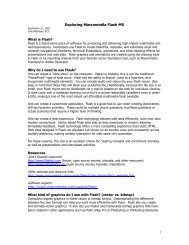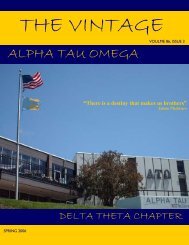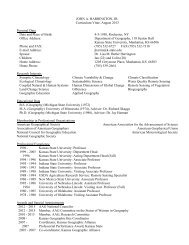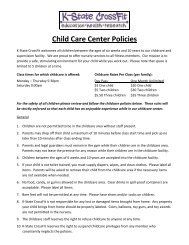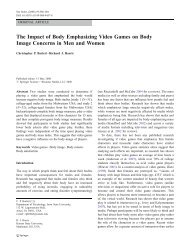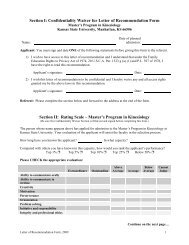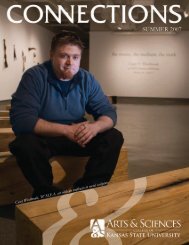Information - Kansas State University
Information - Kansas State University
Information - Kansas State University
Create successful ePaper yourself
Turn your PDF publications into a flip-book with our unique Google optimized e-Paper software.
<strong>Kansas</strong> <strong>State</strong> <strong>University</strong><br />
Department of Chemistry<br />
This presentation will provide you with information<br />
about some of the many different research topics<br />
that we offer.<br />
Feel free to take a virtual trip through our<br />
Department (use the slide show option) and do not<br />
hesitate to contact us if you have any questions or<br />
comments.<br />
Prof. Aakeröy: aakeroy@ksu.edu or 785-532 6096
Going to graduate School<br />
How about <strong>Kansas</strong> <strong>State</strong> <strong>University</strong>
You can make new molecules...
Aufsicht<br />
...or study their properties.
Several focus areas<br />
Asymmetric catalysis<br />
Biophysical chemistry<br />
Drug design in theory<br />
and practice<br />
Structure and bonding<br />
Bioanalytical chemistry<br />
and chemical sensors<br />
Materials science and<br />
nanotechnology<br />
Supramolecular chemistry and crystal engineering
Biological sensors<br />
Electronic structure<br />
Quantum chemistry<br />
Chemical separation<br />
Biophysical<br />
chemistry<br />
Ultrasensitive microscopy<br />
Single-molecule spectroscopy
Professor Christine Aikens<br />
Quantum chemistry<br />
Application of electronic structure methods to:<br />
Nanoparticles<br />
Nanostructured materials<br />
Complex intermetallics<br />
Quasicrystals<br />
To investigate:<br />
Optical properties<br />
Interparticle interactions<br />
Growth mechanisms<br />
Design and programming of<br />
efficient algorithms in the<br />
GAMESS program
Nanostructured Materials<br />
Control over assembly of nanoparticles is<br />
primary obstacle to bottom-up construction of<br />
novel materials and devices<br />
Goals:<br />
•Understand the interactions between<br />
nanoscale building blocks<br />
•Achieve control over these interactions<br />
•Elucidate how certain types of interactions<br />
lead to specific target structures<br />
Self-assembly of<br />
colloidal crystals<br />
Binary nanoparticle<br />
superlattices<br />
Shevchenko, E. V. et al.<br />
Nature 2006, 439, 55.<br />
Murray, C. B. et al. Science 1995, 270, 1335.<br />
Aikens Group
Complex Intermetallics<br />
Complex intermetallic icosahedral alloys<br />
– Excellent long-range order but no periodicity<br />
How do these structures form<br />
Goals:<br />
– Cluster-by-cluster<br />
– Atom-by-atom<br />
• Explain stability of gas-phase clusters<br />
• Determine structural motifs in these clusters<br />
• Examine the atom-by-atom growth mechanism<br />
in order to determine its viability<br />
icosahedral Zn-Mg-Dy<br />
Aikens Group
Professor Viktor Chikan<br />
Physical Chemistry and Material Chemistry<br />
Research Interest<br />
Physical chemistry of nanostructuresoptical,<br />
electrical properties and<br />
thermodynamics of doped quantum confined<br />
semiconductor systems<br />
Synthesis of Doped Nanostructures<br />
Controlling the conductivity (carrier density, carrier<br />
mobility) in quantum confined semiconductor devices is<br />
important for future applications. We are developing<br />
synthetic methods of creating doped quantum dots. In<br />
addition, we are interested in doping intrinsically<br />
anisotropic (such as GaSe quantum dots) and<br />
extrinsically anisotropic quantum confined systems (e.g.<br />
CdSe quantum rods).
Time-domain Terahertz Spectroscopy of Doped Nanostructures<br />
1 THz = 300 µm = 33 cm -1 = 4.1 meV<br />
Measuring the<br />
conductivity of the<br />
doped nanostructures is<br />
challenging because of<br />
the difficulty to<br />
connecting them to<br />
external circuitry.<br />
Terahertz radiation<br />
generated by an<br />
ultrafast laser provides<br />
a convenient way to<br />
measure the frequency<br />
dependant complex<br />
conductivity of the<br />
doped nanostructures.
Ultrafast Carrier Dynamics<br />
(Time-resolved Terahertz Spectroscopy)<br />
While Time-domain<br />
Terahertz Spectroscopy<br />
offers a way to probe the<br />
equilibrium conductivity<br />
of the doped system,<br />
Time-resolved Terahertz<br />
Spectroscopy provides a<br />
way to measure the<br />
transient conductivity in<br />
doped quantum dots, p-<br />
n junctions and 3D<br />
quantum Wells.
Professor Christopher Culbertson<br />
Bioanalytical Chemistry -<br />
Separations, Microfluidics, and Cell Analysis<br />
We are interested in<br />
developing new separation<br />
and sample handling<br />
components for microfluidic<br />
(Lab-on-a-Chip) devices and<br />
then using these devices to<br />
solve interesting bioanalytical<br />
problems.<br />
These devices may facilitate 1) the early diagnosis and successful<br />
treatment of diseases like cancer, and 2) a better understanding<br />
how complex organisms develop from single cells.
Prof. Christopher Culbertson<br />
Buffer<br />
Sample<br />
Waste<br />
5.08 cm<br />
SW<br />
High Efficiency Separations<br />
3.0<br />
2.5<br />
D<br />
E<br />
S<br />
G<br />
Q<br />
P<br />
T<br />
A<br />
10mM Borate/50mM SDS w/ 10% i-PA<br />
l = 11.84 cm; E sep = 740 V/cm<br />
Single Cell<br />
Analysis<br />
2.0<br />
1.5<br />
1.0<br />
0.5<br />
N<br />
C<br />
Y<br />
V<br />
M I L<br />
K<br />
F<br />
K<br />
W<br />
R<br />
0.0<br />
70<br />
80<br />
90<br />
100<br />
110 120 130<br />
Elution time (sec)<br />
140<br />
150<br />
160<br />
170
Professor Dan Higgins<br />
Analytical Chemistry, Materials Chemistry, Optical<br />
Microscopy and Spectroscopy<br />
Single Molecule Spectroscopy<br />
Near-field Scanning Optical Microscopy (NSOM)
1. High Resolution Optical Microscopy Studies of<br />
Liquid-Crystal/Polymer Composites<br />
Multiphoton Excited Fluorescence Microscopy<br />
Near-Field Optical Microscopy<br />
Aluminu m<br />
125 µm<br />
Optical<br />
Fiber<br />
100 nm<br />
Conventional<br />
Fluorescence<br />
Two Photon Excitation<br />
Near Field<br />
Far Field<br />
Higgins Group<br />
Detector<br />
2.Polymer/LC Composites: Order LC Droplet Arrays and<br />
Photorefractive Materials<br />
NSOM Imaging: Photorefractive LCs<br />
Multiphoton Excited Fluorescence:<br />
Hexagonal LC Droplet Arrays<br />
4 µm<br />
Topography<br />
Birefringence<br />
Fluorescence<br />
4 µm<br />
Asymmetric Laser Beam Diffraction<br />
Pu<br />
Pr<br />
2 µm<br />
Hall and, Higgins, J. Phys. Chem, in press.<br />
Higgins Group<br />
Luther, Springer, Higgins, Chem. Mater., 2001, 13, 2281.
3. Organic Photovoltaics:<br />
Self-Assembly of New Solar<br />
Cell Materials<br />
Dye/Polymer<br />
Composites<br />
O N O<br />
N(CH 3<br />
) 3<br />
+<br />
X-<br />
Fluorescence<br />
1200<br />
1100<br />
1000<br />
900<br />
Domain Organization<br />
O<br />
N<br />
O<br />
C 12 -PDI +<br />
0<br />
50<br />
100<br />
150<br />
Polarization (degrees)<br />
Higgins Higgins Group Group
Professor Takashi Ito<br />
Analytical Chemistry (Chemical Sensing), Electrochemistry,<br />
Self-Organized Nanostructural Materials, Nanofluidics<br />
Our Research Interests:<br />
1. Synthesize and characterize novel selforganized<br />
nanostructural materials<br />
with uniform domain morphologies.<br />
2. Clarify molecular-level mass- and<br />
charge-transport within the nanoscale<br />
domains.<br />
3. Apply these materials for chemical<br />
sensing, separations and energy-related<br />
technologies.
Preparation and Characterization of Nanoporous Materials<br />
• Design and prepare monolithic materials comprising an array of<br />
self-organized cylindrical nanopores with uniform pore sizes.<br />
• Characterize the properties of nanopores using electrochemical,<br />
spectroscopic and microscopic techniques.<br />
Anodic nanoporous metal oxides<br />
Block copolymers<br />
Electrochemical<br />
characterization<br />
1) T. Ito, A. A. Audi, G. P. Dible Anal. Chem. 2006, 78, 7048.<br />
2) Y. Li, H. C. Maire, T. Ito Langmuir 2007, 23, 12771.<br />
3) Y. Li, T. Ito Langmuir 2008, 24, 8959.<br />
4) H. C. Maire, S. Ibrahim, Y. Li, T. Ito Polymer 2009, 50, 2273.<br />
5) D. M. N. T. Perera, T. Ito Analyst 2010, 135, 172.<br />
6) F. Li, R. Diaz, T. Ito RSC Adv. 2011, 1, 1732.<br />
7) S. Ibrahim, S. Nagasaka, D. S. Moore, D. A. Higgins, T. Ito ECS Trans. 2012, 41, 1.<br />
8) B. Pandey, P. Thapa, D. A. Higgins, T. Ito Langmuir 2012, 28, 13705.
Applications of Nanoporous Materials<br />
1. Fundamental Studies on Mass-<br />
Transport within Nanodomains<br />
• Single-molecule spectroscopy<br />
(in collaboration with Prof. Higgins)<br />
2. Chemical Sensing with<br />
Cylindrical Nanodomains<br />
• Uniform pore sizes and shapes<br />
size-selective sensing media<br />
• Controllable surface chemistry<br />
chemically selective sensing media<br />
1) K. H. Tran Ba, T. A. Everett, T. Ito, D. A. Higgins Phys.<br />
Chem. Chem. Phys. 2011, 13, 1827.<br />
2) A. W. Kirkeminde, T. Torres, T. Ito, D. A. Higgins J. Phys.<br />
Chem. B 2011, 115, 12736.<br />
3) S. C. Park, T. Ito, D. A. Higgins J. Phys. Chem. B in press.<br />
4) K.-H. Tran-Ba, J. J. Finley, D. A. Higgins, T. Ito J. Phys.<br />
Chem. Lett. 2012, 3, 1968.<br />
1) Y. Li, T. Ito Anal. Chem. 2009, 81, 851.<br />
2) S. Ibrahim, T. Ito Langmuir 2010, 26, 2119.<br />
3) T. Ito, I. Grabowska, S. Ibrahim Trends Anal. Chem. 2010, 29, 225.<br />
4) D. M. N. T Perera, B. Pandey, T. Ito Langmuir 2011, 27, 11111.<br />
5) B. Pandey, K. H. Tran Ba, Y. Li, R. Diaz, T. Ito Electrochim. Acta<br />
2011, 56, 10185.<br />
6) F. Li, B. Pandey, T. Ito Langmuir, submitted.
Professor Jun Li<br />
Analytical Chemistry and Materials Chemistry<br />
Research Interest<br />
The growth and characterization of nanowire<br />
materials (carbon nanotubes/nanofibers, inorganic<br />
semiconducting or metal nanowires), the fabrication<br />
and integration of nanowire materials into solid-state<br />
micro/nano- devices, and the development of novel<br />
nanodevices (particular electronic devices) for<br />
analytical and biomedical applications.<br />
Goal<br />
Our goal is to develop new biosensors and<br />
nanobiotechnologies for environmental, security, and<br />
biomedical applications through the innovation in<br />
nanomaterials growth and device integration and<br />
collaboration with industries and government<br />
agencies.<br />
Plasma Enhanced Chemical Vapor<br />
Deposition<br />
Graphite SWNT MWNT Carbon Nanofibers
Nanotechnology Platforms Based on<br />
Vertically Aligned Nanowires<br />
Mechanical<br />
Electrical<br />
Biomimetic Dry Adhesives<br />
Electrical<br />
MWCNT/CNF<br />
Electrical<br />
Ultrasensitve Nucleic<br />
Acid Detection<br />
E. Coli<br />
Nanoscale IC Interconnects<br />
Thermal &<br />
Mechanical<br />
Inorganic Nanowires<br />
Electronic<br />
Electrical<br />
Ultrasensitive Immunosensor<br />
Thermal Interface Materials<br />
Vertical Nanoelectronics<br />
and nanophotonics<br />
Neural Electrical Interface
Fabrication of Carbon Nanofiber Nanoelectrode<br />
Arrays for Biosensing<br />
As-grown CNF arrays Inlaid CNF arrays in SiO 2<br />
Micropatterned<br />
2 mm<br />
30 dies on a 4” wafer<br />
50 mm<br />
Nanopatterned<br />
200 mm<br />
A 3x3 microelectrode<br />
5 mm<br />
carbon nanofiber arrays<br />
on each microelectrode<br />
Nonpatterned<br />
J. Li, et al, Nanoletters, 3(5), 597-602 (2003).<br />
J. Li, et al, Appl. Phys. Lett., 82(15), 2491 (2003).<br />
J. Koehne, et al., Clinic. Chem. 50:10, 1886 (2004).<br />
500<br />
nm
Professor Ryszard Jankowiak<br />
Physical, biophysical, and analytical chemistry<br />
Photosynthesis<br />
Research<br />
Cancer<br />
Research<br />
N1
The primary events of interest are excitation energy transfer and<br />
charge separation, both of which involve arrays of interacting<br />
chlorophyll molecules and other cofactors that are held in strategic<br />
positions by protein scaffolding.<br />
Photosynthesis Research<br />
Solar energy driven<br />
primary events of<br />
photosynthesis; molecular<br />
electronics…
Cancer Research<br />
Understanding the activity of<br />
carcinogens, structure of DNA<br />
adducts, and development of<br />
advanced biomonitoring<br />
techniques<br />
for cancer risk assessment…<br />
Develop novel methods/devices for screening estrogen-derived DNA<br />
adducts, conjugates, and metabolites in human samples<br />
immunoaffinity biosensor columns with imaging capabilities…<br />
innovative MAb-based biosensors on glass, polymer, and/or silicon wafer<br />
substrates with multiple addressable patches on the surface designed and built<br />
for detection of CEQ-derived biomarkers<br />
Detection will be based on a novel “first-come-first-served” approach and<br />
fluorescence based imaging. Human samples to be studied include: urine, serum,<br />
and tissue extracts obtained from human breast and prostate cancer patients…
Professor Paul Smith<br />
Biophysical chemistry<br />
Co-solvent effects on peptides<br />
and proteins.<br />
Modeling of opioid peptides and<br />
their receptors.<br />
Computer simulation of the structure<br />
and dynamics of peptides, proteins<br />
and nucleic acids.
The general focus of the group is the study of the effects of solvent and<br />
cosolvents on the structure and dynamics of biomolecules in solution. Our<br />
main tool is molecular dynamics simulations which are used to provide<br />
atomic level detail concerning the properties of these molecules.<br />
Our current research is focused in several areas<br />
Cosolvent Effects on Peptides and Proteins<br />
Why do urea and gdmcl denature proteins<br />
How does trifluoroethanol induce helix structure<br />
What does the denatured state of a protein look like<br />
Opioid peptides and delta-opioid receptor modeling<br />
What does the delat-opioid receptor look like<br />
What is the active conformation of receptor agonists<br />
What is the conformational change of the receptor on activation<br />
Improved force field parameters<br />
How can we improve our ideas of how atoms/molecules interact
Opioid peptides and delta-opioid receptor<br />
modeling<br />
Opioids are small peptides that play a major role in<br />
our response to pain. The design of improved and<br />
non addictive new pain killing drugs depends on an<br />
understanding of the interaction between opioids<br />
and their receptor. The exact site of opioid peptide<br />
binding to the receptor is unknown. We have<br />
recently developed a model for the delta-opioid<br />
receptor (see right) which can be used to probe the<br />
interactions between potential drug molecules and<br />
the receptor.<br />
By simulating the conformational preferences<br />
of known delta-opioid receptor agonists one<br />
can speculate on the bioactive conformation<br />
of the peptides required for receptor activation<br />
(see left for Deltorphin I).
Organometallic chemistry<br />
New catalysts<br />
Nanoparticles<br />
Environmental protection<br />
Molecular magnets<br />
Zeolite mimics<br />
Supramolecular chemistry
Professor Christer Aakeröy<br />
Supramolecular synthesis and structural chemistry<br />
Fundamental crystal engineering<br />
Design of functional solids<br />
Supramolecular synthesis<br />
Molecular sociology
Interactions between<br />
molecules control...<br />
Key steps in supramolecular synthesis<br />
Recognition<br />
…the bouquet of wine,...<br />
…the ability of a drug to<br />
block an enzyme,...<br />
<br />
Binding<br />
<br />
Organization<br />
<br />
This needs to be achieved<br />
without making or breaking<br />
any covalent bonds!<br />
We use hydrogen bonds and<br />
halogen bonds as molecular<br />
‘glue’ for linking different<br />
building blocks into predictable<br />
architectures.<br />
Function<br />
R<br />
O<br />
O<br />
H<br />
H<br />
O<br />
O<br />
R<br />
R<br />
O<br />
N<br />
H<br />
H<br />
N<br />
O<br />
H<br />
R<br />
…and the formation of<br />
thunder clouds.<br />
R<br />
H<br />
N<br />
H<br />
O<br />
O<br />
H<br />
N<br />
H<br />
R<br />
H
S (mg/mL)<br />
1. Supramolecular inorganic chemistry (NSF support)<br />
L L<br />
M<br />
L L<br />
L<br />
M<br />
L<br />
M=Pt, Pd, Ni,Cu(I)<br />
L<br />
M<br />
M=Ru, Ir, Rh, Fe, Co<br />
L<br />
L<br />
L M L<br />
L<br />
L<br />
Porous materials and<br />
nanoparticles.<br />
2-D<br />
3-D<br />
2. Supramolecular organic chemistry (NSF support)<br />
(SR)<br />
Ternary cocrystals<br />
Molecular capsules<br />
3. Pharmaceutical chemistry (Industry Support)<br />
0.5000<br />
0.4500<br />
0.4000<br />
0.3500<br />
0.3000<br />
Solubility studies of HMBA @ 24hrs<br />
Why compounds fail or slow down in development<br />
0.2500<br />
0.2000<br />
0.1500<br />
0.1000<br />
0.0500<br />
We have shown that cocrystals<br />
of anti-cancer agents<br />
can improve properties such<br />
as solubility.<br />
0.0000<br />
4,4-HMBA HMBA + Suc HMBA + Adip HMBA + Sub HMBA + Seb<br />
API & Cocrystal<br />
Aqueous solubility of the drug can be modulated!<br />
The solubility can be increased or decreased<br />
compared to that of the drug itself.
Professor Chris Levy<br />
Organometallic chemistry and catalysis<br />
Our primary interests are the<br />
development of new stereospecific<br />
catalysts for organic transformations and<br />
polymerizations and the investigation of<br />
organometallic structure and mechanism.<br />
R 1 R 2<br />
[O]<br />
OH<br />
R 1 R 2<br />
We are creating new helical<br />
transition metal catalysts for<br />
the following asymmetric<br />
transformations:<br />
R 1 R 2<br />
O<br />
[O]<br />
R 1 R 2<br />
R 3 R 4<br />
R 3<br />
R 4<br />
O<br />
S [O] S<br />
R 1 R 2 R 1 R 2
Some new helical complexes and their structures.<br />
N<br />
N<br />
OHHO<br />
NaOMe, 25ûC N N<br />
+ FeCl 2 Fe<br />
Toluene, EtOH O O<br />
20h r.t.<br />
HH<br />
H H<br />
H<br />
N<br />
OH<br />
N<br />
HO<br />
+ ZnCl 2<br />
NaOMe, 25ûC<br />
N N<br />
Zn<br />
O O
Professor Eric Maatta<br />
eam@ksu.edu<br />
Synthetic Inorganic and Materials Chemistry<br />
Polyoxometalate clusters<br />
Multinuclear NMR studies<br />
Metal-ligand multiple bonds<br />
Transition metal catalysis<br />
Hybrid materials<br />
really big molecules
A couple of our favorites . . .<br />
A soluble polystyrene incorporating a<br />
redox-active polyoxometalate cluster<br />
A nitrido-polyoxometalate:<br />
[(Os VI N)P 2 W 17 O 61 ] 7-
Professor Emily McLaurin<br />
Inorganic Chemistry and Materials Chemistry<br />
Sensing of biological analytes<br />
Heterostructures for catalysis<br />
New materials for solar light harvesting<br />
Energy transfer and charge transfer at interfaces
Material surfaces and interfaces<br />
Surface chemistry plays a critical role<br />
in the properties of nanomaterials.<br />
Changing the material surface adjusts<br />
the particle solubility, conductivity,<br />
stability, and luminescence among<br />
other properties.<br />
Doped materials for ratiometric sensing<br />
+ analyte<br />
Synthesis of new transition<br />
metal-doped semiconductor<br />
nanomaterials allows for<br />
exploration of new sensing<br />
mechanisms using dopant<br />
related properties. The dopant<br />
also acts as a probe of the<br />
semiconductor surface.
New materials for light harvesting and catalysis<br />
Asymmetry<br />
Materials that absorb a large part of<br />
the solar spectrum are often easily<br />
oxidized. Stability can be enhanced<br />
using new structures and materials.<br />
Charge separation in semiconductor<br />
nanomaterials can be improved by<br />
formation of hetero- and asymmetric<br />
structures as well as alternative<br />
morphologies.<br />
New morphologies<br />
Heterostructures<br />
Examination of energy and charge transfer<br />
processes affecting hybrid organic-semiconductor<br />
and metal-semiconductor systems can improve<br />
solar conversion and storage efficiencies.
Total synthesis<br />
Proteins and peptides<br />
Anti-cancer drugs<br />
Host-guest chemistry<br />
Regioselective catalysis<br />
Ferroelastic materials
Professor Stefan Bossmann<br />
Organic, Bioinorganic and Materials Chemistry<br />
Stem Cell<br />
Identification<br />
Optical Tomography<br />
Tumor Imaging
Professor Stefan Bossmann<br />
Organic, Bioinorganic and Materials Chemistry<br />
Synthesis of Fe(0)-Nanoparticles for Tumor Imaging,<br />
Hyperthermia Treatment of Cancer and Catalytic Applications
Professor Stefan Bossmann<br />
Organic, Bioinorganic and Materials Chemistry<br />
Stem Cells and Defensive Cells take up of Fe(0)-nanoparticles and<br />
transport them to tumors thus permitting cell-based cancer therapy.<br />
A: Melanoma in a Black Mouse; B: Stem Cells (red) travel to the<br />
location of tumors/metastases<br />
This work is performed in close collaboration with Prof. Dr. Deryl L.<br />
Troyer, Department of Anatomy&Physiology
Professor Mark Hollingsworth<br />
Physical-Organic and Solid-<strong>State</strong> Organic Chemistry
Probing the elastic properties of materials - studies of<br />
ferroelastic and ferroelectric domain switching<br />
Domain switching is an important phenomenon in<br />
technological devices, but it also can be used as a<br />
tool to understand how elastic properties of<br />
crystals are affected by internal molecular<br />
structures, impurities and defect structures.<br />
2,10-Undecanedione/urea crystals contain<br />
ferroelastically distorted domains that are<br />
twinned across two types of boundaries<br />
to give as many as twelve sectors.<br />
Pure crystals of this material<br />
undergo irreversible (plastic)<br />
domain reorientation (above),<br />
but 2-undecanone impurities<br />
can make this process elastic.<br />
(See videos on the next page.)<br />
before stress after stress<br />
As a complement to SWBXT,<br />
birefringence mapping using the<br />
Metripol microscope gives both<br />
indicatrix orientation (upper) and<br />
Synchrotron white beam X-ray<br />
topography (SWBXT) images<br />
taken before and after stress for<br />
optical retardation (lower) and<br />
reveals disorder both within and<br />
between domains, especially at<br />
crystals containing 10% (top), 14% boundaries that show epitaxial<br />
(middle) and 18% 2-undecanone mismatches.<br />
(bottom) show that impurities<br />
unpin stressed defect sites and<br />
make domain switching reversible.<br />
By generating a large series of ferroelastic inclusion compounds that are closely related to each other,<br />
and then comparing domain switching in these crystals as a function of impurities, it is possible to show<br />
that the impurities control the dynamics and reversibility of domain switching by breaking up cooperative<br />
hydrogen bonding networks and unpinning stressed sites in these crystals.
Ferroelectric domain switching in inclusion<br />
compounds of tetra-t-butylcalix[4]arene<br />
O<br />
N<br />
O<br />
-<br />
+<br />
+<br />
N<br />
O -<br />
Host structure<br />
In an electric field, the guests rotate<br />
about the pseudo-fourfold axis of the host<br />
X<br />
X<br />
X<br />
Y<br />
X<br />
Y<br />
Z<br />
Y<br />
X<br />
Z(X')<br />
X<br />
Which of the above guests could show<br />
ferroelectric domain switching
Professor Duy H. Hua<br />
Synthesis and Bio-evaluation of Natural and Unnatural Products,<br />
Design of Enzyme Inhibitors, and Syntheses of Beltenes and<br />
Nanomaterials<br />
Anti-cancer agents targeting<br />
Gap junction intercellular<br />
communication<br />
Development of new stereo-selective reactions<br />
Synthesis of nanogels for selective drug delivery
Two major research projects are being carried out in our<br />
group, and they are: synthesis, mechanism, and<br />
bioevaluation of biologically active compounds and<br />
syntheses and applications of beltenes and nanomaterials.<br />
Bioactive<br />
Compounds<br />
O<br />
Biophysical Analyses<br />
Releasing of blood vessel<br />
H<br />
H<br />
O<br />
O<br />
CO 2 H<br />
Myriceric Acid A<br />
for release of vasospasm<br />
OH<br />
OH<br />
O<br />
H<br />
O<br />
O<br />
N<br />
CH 3<br />
NH 2<br />
N<br />
N<br />
N<br />
A Tricyclic Pyrone Adenine<br />
for disaggregation of A42<br />
oligomers<br />
Surface Plasmon Resonance of<br />
A and CP2<br />
RO<br />
Duy H. Hua<br />
R'HN<br />
OAr<br />
N<br />
Quinolines for gap junction<br />
intercellular communication<br />
Gap junction channel and PQ1
Duy H. Hua<br />
R 1 R 2 R 2<br />
Synthetic targets<br />
R 1 R 2 R 2<br />
R 2<br />
R 1 R 2<br />
R 1<br />
R 1<br />
R 2 R 1<br />
R 2<br />
R 1<br />
R 1 R 2<br />
R 2<br />
R 1 [12]Cyclacenes<br />
R1<br />
R 2 R 2<br />
R 1 R 1<br />
10.64 Å<br />
9.71 Å<br />
Armchair Carbon nanotube<br />
Atomic force microscopic<br />
images of functionalized<br />
carbon nanotubes<br />
1<br />
H- 15 N-HSQC spectrum of A40<br />
peptide<br />
Bar is 0.5 mm.
Professor Ping Li<br />
Chemical Biology/Bioorganic Chemistry<br />
Research Interests<br />
Use synthetic organic chemistry<br />
and molecular biology as major<br />
tools to study and manipulate<br />
biologically<br />
important<br />
enzymes/proteins. Currently, I<br />
have four projects in my lab.
1. Studies of ghrelin acylation by ghrelin<br />
O-acyltransferse (GOAT).<br />
GOAT was recently discovered 1-2 as a potential drug target<br />
for curing obesity. We will investigate its molecular<br />
mechanisms and design effective inhibitors to it.<br />
1. Gutierrez, J. A.; Solenberg, P. J.; Perkins, D. R.; Willency, J. A.; Knierman, M. D.; Jin, Z.;<br />
Witcher, D. R.; Luo, S.; Onyia, J. E.; Hale, J. E. Proc. Natl. Acad. Sci. USA 2008, 105, 6320.<br />
2. Yang, J.; Brown, M. S.; Liang, G.; Grishin, N. V.; Goldstein, J. L. Cell 2008, 132, 387.<br />
Commercial products made of PHA<br />
2. Mechanistic studies of polyhydroxyalkonate<br />
(PHA) biosynthesis.<br />
Biodegradable plastic PHAs can substitute oil-based<br />
plastics that are non-biodegradable. Our ultimate<br />
goal is to understand mechanisms of proteins<br />
involved in PHA biosynthesis and to engineer them<br />
to produce PHAs in an economically competitive<br />
fashion, which will help to protect our environment<br />
and save energy.
3. Investigation of peptidoglycan glycosyltransferases<br />
(PGTs) in peptidoglycan<br />
biosynthesis.<br />
PGT catalyze the final step of polymerizing Lipid II to<br />
form the nascent bacterial wall. Because their function<br />
is unique and essential for bacterial survival, PGTs<br />
have been the major target of clinically used<br />
antibiotics. Our goals are to understand the<br />
mechanism of substrate recognition by PGTs, to<br />
develop a model that can predict interactions between<br />
PGTs and substrate, and to design novel inhibitors to<br />
PGTs.<br />
4. Site-specific protein labeling using SNAP tag.<br />
Selective labeling of proteins has become an essential tool to<br />
visualize and characterize biological activities inside living cells.<br />
The SNAP tag was first introduced by Kai Johnsson using a human<br />
O 6 -alkylguanine-DNA alkyltransferase (hAGT), which transfers the<br />
alkyl group from its substrate, O 6 -alkylguanine-DNA to one of its<br />
cysteine residues. Our goals are to develop novel small molecule<br />
probes for specific labeling and apply this technology for detection<br />
of protein-protein interactions.
Professor Ryan J. Rafferty<br />
Organic Chemistry & Chemical Biology<br />
Total Synthesis<br />
Development of Selective<br />
Drug Delivery Systems<br />
Drug Discovery<br />
and Evaluation<br />
Structurally Remodeling for Library Construction<br />
Blood-Brain Barrier Penetration<br />
Investigation, Enhancement, and Therapeutic
Total Synthesis, Structurally Remodeling for Library<br />
Construction, Drug Discovery and Evaluation<br />
•Total Synthesis Campaigns of Biologically<br />
Interesting Compounds<br />
•Structural Remodeling of Natural Products<br />
and Complex Intermediates<br />
•Library Construction<br />
•Screening Campaigns of Synthesized<br />
Compounds<br />
•Biochemical and Molecular Biology<br />
•Medicinal Chemistry<br />
•Discovery of New Drug Candidates<br />
Rafferty Research Group
Blood-Brain Barrier Penetration<br />
Investigation, Enhancement, and Therapeutic<br />
•Synthesis of Chemical Library Probing<br />
Varying Chemo-physical Properties via<br />
Ring Closing Metathesis, Diels-Alder &<br />
Peripheral Modification reactions<br />
•Evaluation of Compounds Upon Blood<br />
Brain Penetration<br />
•Library Construction<br />
•Elaboration of Scaffolds and Evaluation against various diseases<br />
Nature Reviews Drug Discovery 2007, 6, 650-661<br />
Rafferty Research Group
Development of Selective Drug Delivery Systems<br />
•Targeting Folate Receptors due to Over-<br />
Expression within Cancers and Acidic<br />
Microenvironments<br />
•Enhancement of Drugs to Reduce Off-Target<br />
Side Effects<br />
•Evaluation of system in vitro/vivo<br />
Rafferty Research Group
A few more reasons to consider Graduate<br />
studies in Chemistry at <strong>Kansas</strong> <strong>State</strong>:<br />
• Competitive stipends.<br />
• An expanding and well-funded Department.<br />
• First-rate research in inorganic, organic,<br />
physical, analytical, materials, and biological<br />
chemistry.<br />
• Friendly and helpful staff and faculty.<br />
• Our graduate students have successful careers<br />
(see next few pages for some examples)!
Gregory Roman (Ph. D.<br />
2006)<br />
Assistant Professor<br />
Bryn Mawr College<br />
Andrew Moran (Ph.D. 2002)<br />
Assistant Professor<br />
Univ. of North Carolina, Chapel Hill<br />
Nate Schultheiss (Ph. D. 2007)<br />
Halliburton<br />
(Fulbright Fellow with Jean-<br />
Marie Lehn in 2008)<br />
Gustavo Seabra (Ph.D. 2005)<br />
Professor Adjunto<br />
Universidade Federal de<br />
Pernambuco, Brazil<br />
Dr. Joaquin Urbina<br />
Ph. D. 2005<br />
Professor<br />
<strong>University</strong> of Belize<br />
Dr. Michelle Smith<br />
Ph. D. 2009<br />
GlaxoSmithKline, UK
QuickTime and a<br />
decompre sor<br />
are n eded to s e this picture.<br />
Tom Everett (Ph. D. 2010)<br />
Postdoc<br />
Univ. of Missouri<br />
Dmytro Demydov (Ph. D. 2006)<br />
Research Assistant Professor<br />
Univ. of Arkansas<br />
Safiyyah Forbes (Ph.D. 2010)<br />
Assistant Professor<br />
Monmouth College, Illinois<br />
Johanna Haggstrom (Ph. D. 2007)<br />
Halliburton in Lawton, OK<br />
Dambar Hamal (Ph.D. 2009)<br />
Postdoc<br />
Univ. of Connecticut<br />
Pubudu Gamage (Ph. D. 2009)<br />
Postdoc<br />
Univ. of Wyoming<br />
Yen-Ting Kuo (Ph. D. 2010)<br />
Postdoc<br />
Univ. of Michigan<br />
Jeff Lange (Ph. D. 2009)<br />
Staff Scientist<br />
Stowers Institute for Medical<br />
Research in <strong>Kansas</strong> City
We also have a beautiful Campus..<br />
Anderson Hall<br />
Student Union<br />
The Art Museum<br />
The Farrel library<br />
The Hale library
...with over 20,000 students.
KSU is located in Manhattan...
…in the Flint<br />
Hills, North-<br />
East <strong>Kansas</strong>.
If you need more information about<br />
Chemistry at <strong>Kansas</strong> <strong>State</strong> or if you<br />
want to receive an application<br />
package….<br />
Contact:<br />
Prof. Christer Aakeröy (aakeroy@ksu.edu)<br />
or<br />
Mary Dooley (mldooley@ksu.edu)
Welcome to <strong>Kansas</strong> <strong>State</strong>!<br />
http://www.ksu.edu/chem/



